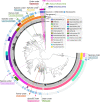Functional and genetic markers of niche partitioning among enigmatic members of the human oral microbiome
- PMID: 33323122
- PMCID: PMC7739484
- DOI: 10.1186/s13059-020-02195-w
Functional and genetic markers of niche partitioning among enigmatic members of the human oral microbiome
Abstract
Introduction: Microbial residents of the human oral cavity have long been a major focus of microbiology due to their influence on host health and intriguing patterns of site specificity amidst the lack of dispersal limitation. However, the determinants of niche partitioning in this habitat are yet to be fully understood, especially among taxa that belong to recently discovered branches of microbial life.
Results: Here, we assemble metagenomes from tongue and dental plaque samples from multiple individuals and reconstruct 790 non-redundant genomes, 43 of which resolve to TM7, a member of the Candidate Phyla Radiation, forming six monophyletic clades that distinctly associate with either plaque or tongue. Both pangenomic and phylogenomic analyses group tongue-specific clades with other host-associated TM7 genomes. In contrast, plaque-specific TM7 group with environmental TM7 genomes. Besides offering deeper insights into the ecology, evolution, and mobilome of cryptic members of the oral microbiome, our study reveals an intriguing resemblance between dental plaque and non-host environments indicated by the TM7 evolution, suggesting that plaque may have served as a stepping stone for environmental microbes to adapt to host environments for some clades of microbes. Additionally, we report that prophages are widespread among oral-associated TM7, while absent from environmental TM7, suggesting that prophages may have played a role in adaptation of TM7 to the host environment.
Conclusions: Our data illuminate niche partitioning of enigmatic members of the oral cavity, including TM7, SR1, and GN02, and provide genomes for poorly characterized yet prevalent members of this biome, such as uncultivated Flavobacteriaceae.
Keywords: Candidate phyla radiation; Human oral cavity; Metagenomics; Metapangenomics; Niche partitioning; Saccharibacteria.
Conflict of interest statement
The authors declare that they have no competing interests.
Figures






References
-
- German RZ, Palmer JB. Anatomy and development of oral cavity and pharynx. GI Motility online [Internet]: Nature Publishing Group; 2006. [cited 2019 Nov 28]. Available from: 10.1038/gimo5.
Publication types
MeSH terms
Substances
Associated data
Grants and funding
LinkOut - more resources
Full Text Sources

